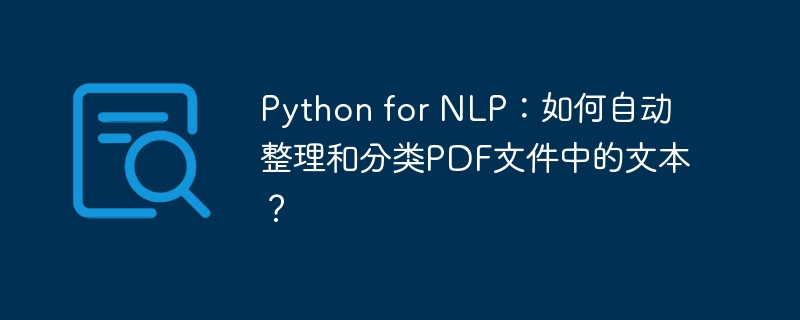

Python for NLP: How to automatically organize and classify text in PDF files?
Abstract:
With the development of the Internet and the explosive growth of information, we are faced with a large amount of text data every day. In this era, automatically organizing and classifying text has become increasingly important. This article will introduce how to use Python and its powerful natural language processing (NLP) functions to automatically extract text from PDF files, organize and classify it.
Before we begin, we need to ensure that the following Python libraries have been installed:
First, we need to use the pdfplumber library to extract text from PDF files.
import pdfplumber
def extract_text_from_pdf(file_path):
with pdfplumber.open(file_path) as pdf:
text = ""
for page in pdf.pages:
text += page.extract_text()
return textIn the above code, we define a function named extract_text_from_pdf to extract text from a given PDF file. The function accepts a file path as a parameter and opens the PDF file using the pdfplumber library, then iterates through each page through a loop and extracts the text using the extract_text() method.
Before text classification, we usually need to preprocess the text. This includes steps such as stop word removal, tokenization, stemming, etc. In this article, we will use the nltk library to accomplish these tasks.
import nltk
from nltk.corpus import stopwords
from nltk.tokenize import word_tokenize
from nltk.stem import SnowballStemmer
def preprocess_text(text):
# 将文本转换为小写
text = text.lower()
# 分词
tokens = word_tokenize(text)
# 移除停用词
stop_words = set(stopwords.words("english"))
filtered_tokens = [word for word in tokens if word not in stop_words]
# 词干提取
stemmer = SnowballStemmer("english")
stemmed_tokens = [stemmer.stem(word) for word in filtered_tokens]
# 返回预处理后的文本
return " ".join(stemmed_tokens)In the above code, we first convert the text to lowercase, and then use the word_tokenize() method to segment the text into words. Next, we use the stopwords library to remove stop words and SnowballStemmer for stemming. Finally, we return the preprocessed text.
Now that we have extracted the text from the PDF file and preprocessed it, we can use machine learning algorithms to classify the text. In this article, we will use the Naive Bayes algorithm as the classifier.
from sklearn.feature_extraction.text import CountVectorizer
from sklearn.naive_bayes import MultinomialNB
def classify_text(text):
# 加载已训练的朴素贝叶斯分类器模型
model = joblib.load("classifier_model.pkl")
# 加载已训练的词袋模型
vectorizer = joblib.load("vectorizer_model.pkl")
# 预处理文本
preprocessed_text = preprocess_text(text)
# 将文本转换为特征向量
features = vectorizer.transform([preprocessed_text])
# 使用分类器预测文本类别
predicted_category = model.predict(features)
# 返回预测结果
return predicted_category[0]In the above code, we first use the joblib library to load the trained naive Bayes classifier model and bag-of-words model. We then convert the preprocessed text into feature vectors and then use a classifier to classify the text. Finally, we return the predicted classification result of the text.
Now, we can integrate the above code and automatically process PDF files, extract text and classify it.
import os
def process_pdf_files(folder_path):
for filename in os.listdir(folder_path):
if filename.endswith(".pdf"):
file_path = os.path.join(folder_path, filename)
# 提取文本
text = extract_text_from_pdf(file_path)
# 分类文本
category = classify_text(text)
# 打印文件名和分类结果
print("File:", filename)
print("Category:", category)
print("--------------------------------------")
# 指定待处理的PDF文件所在文件夹
folder_path = "pdf_folder"
# 处理PDF文件
process_pdf_files(folder_path)In the above code, we first define a function named process_pdf_files to automatically process files in the PDF folder. Then, use the listdir() method of the os library to iterate through each file in the folder, extract the text of the PDF file, and classify it. Finally, we print the file name and classification results.
Using Python and NLP functions, we can easily extract text from PDF files and organize and classify it. This article provides a sample code to help readers understand how to automatically process text in PDF files, but the specific application scenarios may be different and need to be adjusted and modified according to the actual situation.
References:
The above is the detailed content of Python for NLP: How to automatically organize and classify text in PDF files?. For more information, please follow other related articles on the PHP Chinese website!




